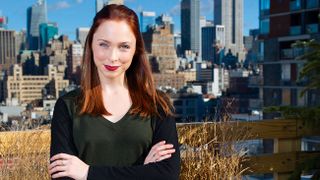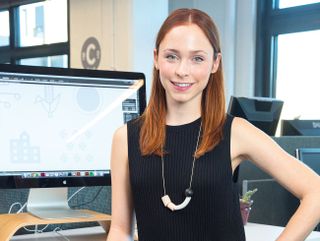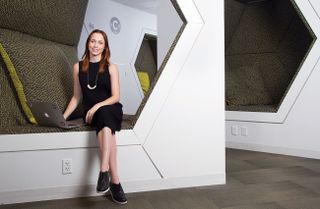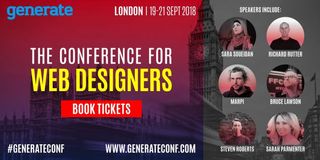Discover Google's UX design secrets
Google's UX designer on visual thinking, helping people do good in the world, and how she found her fire.

This interview took place in 2016.
Rachel Inman doesn't like exclusivity, which directly ties into her role as at Google where she works on perfecting the user experience. Describing herself as a "bit of a nerd" growing up, it reminds her of when one group of kids felt entitled to exclude others.
In a business environment, people can often unconsciously create an 'us versus them' mentality too.
"The 'them' could be the clients, the project managers, your engineering team – anyone you perceive just doesn't get what you're trying to create," she says. "You feel like they are against you or threaten your power. This is dangerous because it can lead to secrecy and defensiveness. Communication breaks down. Egos flare."
A design solution from an engineer is just as valid and celebrated as an engineering idea from a designer
Thankfully in her role as UX designer at Google, Inman is able to ensure everyone on her team has a say. "It's baked into our process," she enthuses. "Engineers, PMs and designers are writing user stories together, disseminating research, and forming a shared understanding of the 'why'."
Not only does this make for a more effective workflow, it also has a positive effect on job satisfaction. "Morale is high because there are no more walls. A design solution from an engineer is just as valid and celebrated as an engineering idea from a designer."
Bigger picture
Inman didn't get to Google with a traditional Computer Sciences degree: she received a BFA in Industrial Design from the Carnegie Mellon School of Design, and also dabbled in architecture and urban design during her time there. "I think I was giving my academic advisor a headache," she remembers. "Every semester, I was maxing out on the units I could take."
Prior to university, she'd attended an art school and concentrated on sculpture of "the type you can't really give your mom for her birthday because it's too unwieldy to put on a shelf." She had planned to continue experimenting with these large sculptures, but found herself questioning her path.
"I started thinking more about what I wanted to put out into the world as a creator. Were my creations making life better for others? I wanted to find a more direct way than sculpture to do good in the world."

The choice led her to CMU. Taking part in industrial design classes there was to, as Inman puts it, "fulfil a desire to affect the entirety of a person's experience." For one project, she spent an entire summer conducting research around Pittsburgh, sitting in public spaces for hours and taking notes on people's activity.
Inman credits the diverse curriculum and opportunities at CMU with helping her see the bigger picture – something that has come in handy at Google.
Small but mighty
Since joining Google, Inman has worked on a wide range of teams and projects. She is currently engaged in building business applications for Google employees to use. Last year, as part of the Google Earth Outreach team, she worked on the launch of Global Fishing Watch – an initiative to monitor fishing activity.
"One of my most exciting days was coming to the UN headquarters to watch my programme manager present a demo to an assembly of island nation representatives," she enthuses. "It was so inspiring to see them get on board with the idea that this tool could really empower their local leaders and environmental activists."
Our project team is small but mighty, which I find really exhilarating
Inman also led the team that redesigned the public-facing site introducing Google Earth Engine. Earth Engine is a resource exploring changes in the Earth's surface; users can sign up to gain access to a wealth of geophysical, climate, weather and demographic datasets. A key aspect of the redesign was to make the site responsive, enabling users to learn about this tool anywhere.
One challenge was to establish what users from different academic disciplines needed to see in order to use the platform in their projects. "Finding out what users wanted wasn't hard; it was narrowing that down to the essentials that was tough, " Inman explains. "Our project team is small but mighty, which I find really exhilarating."
Working at Google has also enabled Inman to learn a different side of UX. Prior to joining the company, she spent three years as a senior experience designer at R/GA, which she describes as "a wonderful training ground" for her design career.
However, predominantly working on commercial sites aimed at helping people buy things meant she soon found herself questioning her path again.
"My desire to feel useful took over and I gravitated towards Google because the products they create provide such great utility to people around the world. They don't rely on flashy interactions – they aim to be intuitive, simple, and occasionally smile-provoking."
Personal goals
Recently, there's been discussion within the industry that some basic aspects of design have become lost under the weight of 'unnecessary' embellishments. Whilst some could argue that designers are failing to focus on their user, Inman says that the basic aspects of design are relative to the individual designer. However, she does concede that at one point or another, all designers will lose their focus on the user.
"We have the best intentions, but other constraints push us in a different direction," she offers. "It's unfortunate, but it happens. Though, if you notice it happening a lot in your workplace, you might want to speak up or head for the door."

She also emphasises that each designer's priorities depend on their personal goals. "Maybe you want to design a game for users to play that will likely distract them from what they really need to do, but does bring them temporary joy. That's valid."
Inman, however, is not interested in creating games. "My definition of necessary is very rooted in a desire to create useful things that help people do good in the world." The key questions she asks are: Does this solution help people accomplish a core goal? Does it engage the user as little as possible, while still giving them maximum value? And finally, can this solution spark exponential good?
How, why and who
Taking all this into account when tackling a new project – at such a large company – is undoubtedly a daunting prospect. Inman begins by investigating the project's background, stakeholders, and the user problems they're trying to address. This usually means digging through a load of documents about previous projects, reviewing research findings, and sometimes learning about a new subject altogether.
"Being transparent about research, insights from users, and my own intentions is an incredibly important part of starting a project," she urges. "Everyone should try to come to a shared understanding around why we're doing this project and who we're doing it for, before we can move on to the 'how'. You can always go back to the 'why' and the 'who' you defined in the beginning, to remind your team of the original mission course."
Everyone should try to come to a shared understanding around 'why' and 'who', before we can move on to the 'how'
Inman also makes diagrams for herself, in order to better understand the problems she's solving. While it's not something she was formally taught, she thinks a lot of designers find this approach helpful, purely because they're visual thinkers.
"I used to do this sort of thing as a kid in science class so I could remember how to complete experiments," she laughs. "The teacher would demonstrate and I'd quickly sketch what she was doing so I could replicate it later."
Despite busying herself with an array of projects at Google, Inman makes time to work as an expert in residence for the General Assembly's New York campus, teaching 'Introduction to UX Design'. She covers a wide range of topics during the 12-week course, but it's a taste for experimentation that she wants her students to gain from the programme.
"In many cases, they come in with no design experience, and leave with a foundation they can build on," she begins. "If my students walk away with any message, I hope it's that they don't need permission to create and experiment. Aside from understanding their users, I really want them to feel free to keep making, testing, failing and continuing. That's the only way they'll get better!"
A vision of the future
While she's busy inspiring others, Inman finds her own inspiration in artists, designers and other thought leaders. Current influences include illustrator and writer Maira Kalman, sculptor Henry Moore and World History of Design author Victor Margolin.
One quote from Margolin has had a particular impact: "Designers occupy a dialectical space between the world that is and the world that could be ... To plan effectively in the present requires a vision of what the future could and should be like."
"This quote resonated with me during a slump," says Inman. "I had been working very hard on several projects and they were all technically going well, but I'd lost the fire inside me."

Around that time, a white paper from CMU arrived in the post. In the margins, the author had included quotes from designers and design thinkers like Margolin. Inman took photos of the quotes, and kept looking at them throughout the week.
"This quote reminded me of the reason I got into this crazy world of design – to try and make the world just a tiny bit better than how I found it," she recalls. "That might seem like a naively optimistic goal, but I still believe it to a certain extent."
This article was originally published in net magazine. Subscribe now.
Sign up to Generate for even more web design secrets

If you work in web design or development then you'll want to attend Generate London on 19-21 September 2018, for lots of good reasons.
The annual conference for web designers and frontend developers is net magazine and Creative Bloq's flagship web event. Featuring 17 fantastic speakers, it covers web animations, performance, UX strategy, adaptive interfaces, accessibility, design and content sprints, and much more.
Get more details on both and get your ticket today.
Related articles:

Thank you for reading 5 articles this month* Join now for unlimited access
Enjoy your first month for just £1 / $1 / €1
*Read 5 free articles per month without a subscription

Join now for unlimited access
Try first month for just £1 / $1 / €1
Get the Creative Bloq Newsletter
Daily design news, reviews, how-tos and more, as picked by the editors.
Sammy Maine was a founding member of the Creative Bloq team way back in the early 2010s, working as a Commissioning Editor. Her interests cover graphic design in music and film, illustration and animation. Since departing, Sammy has written for The Guardian, VICE, The Independent & Metro, and currently co-edits the quarterly music journal Gold Flake Paint.
